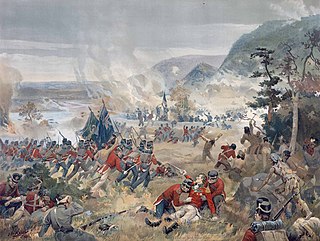
The Battle of Queenston Heights was the first major battle in the War of 1812. Resulting in a British victory, it took place on 13 October 1812 near Queenston, Upper Canada.
The Battle of York was a War of 1812 battle fought in York, Upper Canada on April 27, 1813. An American force, supported by a naval flotilla, landed on the western lakeshore and captured the provincial capital after defeating an outnumbered force of regulars, militia and Ojibwe natives under the command of Major General Roger Hale Sheaffe, the Lieutenant Governor of Upper Canada.

The Battle of Lundy's Lane, also known as the Battle of Niagara, was fought on 25 July 1814, during the War of 1812, between an invading American army and a British and Canadian army near present-day Niagara Falls, Ontario. It was one of the bloodiest battles of the war, and one of the deadliest battles fought in Canada, with approximately 1,720 casualties including 258 killed.
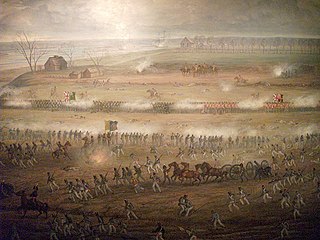
The Battle of Crysler's Farm, also known as the Battle of Crysler's Field, was fought on 11 November 1813, during the War of 1812. A British and Canadian force won a victory over a US force which greatly outnumbered them. The US defeat prompted them to abandon the St. Lawrence Campaign, their major strategic effort in the autumn of 1813.
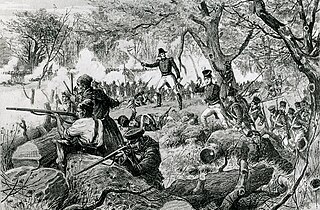
The Battle of the Chateauguay was an engagement of the War of 1812. On 26 October 1813, a combined British and Canadian force consisting of 1,530 regulars, volunteers, militia and Mohawk warriors from Lower Canada, commanded by Charles de Salaberry, repelled an American force of about 2,600 regulars which was attempting to invade Lower Canada and ultimately attack Montreal.

The Battle of Chippawa, also known as the Battle of Chippewa, was a victory for the United States Army in the War of 1812, during its invasion on July 5, 1814, of the British Empire's colony of Upper Canada along the Niagara River. This battle and the subsequent Battle of Lundy's Lane demonstrated that trained American troops could hold their own against British regulars. The battlefield is preserved as a National Historic Site of Canada.

The Second Battle of Sacket's Harbor, or simply the Battle of Sacket's Harbor, took place on 29 May 1813, during the War of 1812. A British force was transported across Lake Ontario and attempted to capture the town, which was the principal dockyard and base for the American naval squadron on the lake. Twelve warships were built here. The British were repulsed by American regulars, militia, marines and sailors.

The siege of Fort Erie, also known as the Battle of Erie, from 4 August to 21 September 1814, was one of the last engagements of the War of 1812, between British and American forces. It took place during the Niagara campaign, and the Americans successfully defended Fort Erie against a British army. During the siege, the British suffered high casualties in a failed storming attempt; they also suffered casualties from sickness and exposure in their rough encampments. Unaware that the British were about to abandon the siege, the American garrison launched a sortie to destroy the British siege batteries, during which both sides again suffered high losses.

The Battle of Fort George was fought during the War of 1812, in which the Americans defeated a British force and captured Fort George in Upper Canada. The troops of the United States Army and vessels of the United States Navy cooperated in a very successful amphibious assault, although most of the opposing British force escaped encirclement.

The Battle of Bladensburg, also known as the Bladensburg Races, took place during the Chesapeake Campaign, part of the War of 1812, on 24 August 1814, at Bladensburg, Maryland, 8.6 miles (13.8 km) northeast of Washington, D.C.
The Raid on Gananoque was an action conducted by the United States Army on 21 September 1812 against Gananoque, Upper Canada during the War of 1812. The Americans sought to plunder ammunition and stores to resupply their own forces. Gananoque was a key point in the supply chain between Montreal and Kingston, the main base of the Provincial Marine on the Great Lakes. Under the command of Captain Benjamin Forsyth, the Americans departed Ogdensburg, New York and sailed to Gananoque, where they encountered resistance from the 2nd Regiment of Leeds Militia. The British militia was forced to retreat and the Americans successfully destroyed the storehouse and returned to the United States with captured supplies. As a result of the raid, the British strengthened their defences along the St. Lawrence River.

The Capture of Fort Niagara took place 18-19 December 1813 during the War of 1812 between Great Britain and the United States. The American garrison was taken by surprise, and the fort was captured in a night assault by a select force of British regular infantry.

The Battle of Fort Ontario was a partially successful British raid on Fort Ontario and the village of Oswego, New York on May 6, 1814 during the War of 1812.
Brevet Lieutenant-Colonel Benjamin Forsyth served as a United States Army officer during the War of 1812. Born in North Carolina, Forsyth joined the United States Army in 1800 as an officer and was a captain of the Regiment of Riflemen at the outbreak of war in 1812. He led raids into Upper Canada along the Saint Lawrence River in 1812–13 before transferring south and taking part in the battles of York and Fort George. Brevetted to lieutenant-colonel, he held command along Lake Champlain. He was mortally wounded at Odell Town, Lower Canada, in 1814.
The Glengarry Light Infantry Fencibles were a light infantry unit, raised chiefly in the Glengarry District of Upper Canada shortly before the outbreak of the Anglo-American War of 1812. The unit fought throughout the war, and was disbanded shortly afterwards.

The Regiment of Riflemen was a unit of the U.S. Army in the early nineteenth century. Unlike the regular US line infantry units with muskets and bright blue and white uniforms, this regiment was focused on specialist light infantry tactics, and were accordingly issued rifles and dark green and black uniforms to take better advantage of cover. This was the first U.S. rifleman formation since the end of the American Revolutionary War 25 years earlier.
Where can you find troops more efficient than Morgan's riflemen of the Revolution or Forsyth's riflemen of the last war with Great Britain?
Under the designation Regiment of Light Dragoons existed two different units of the U.S. Army in the late eighteenth and early nineteenth centuries, respectively. A first unit of its name was short lived, established just prior the Quasi-War with France, in 1798 and discharged in 1800.
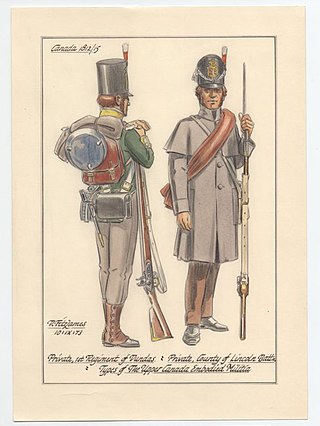
The Dundas County Militia was a regiment of the provincial militia of Upper Canada that was raised in Dundas County, Ontario, in the 1780s. The battle honours and legacy of the Dundas Militia are perpetuated by the Stormont, Dundas and Glengarry Highlanders.
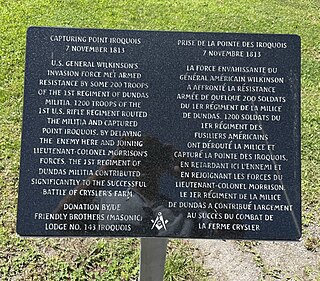
The Battle of Point Iroquois was a small skirmish fought on the morning of November 8, 1813, as part of Wilkinson's advance up the St. Lawrence towards Montreal. The skirmish occurred on the shores of the St. Lawrence River at Point Iroquois, Dundas County, where the river reached its narrowest point, only 500 yards across.
The Assault on Ogdensburg, also known as the First Battle of Ogdensburg or the Battle of Prescott, was an attack by Canadian militia on the American defences at Ogdensburg on October 4, 1812.















